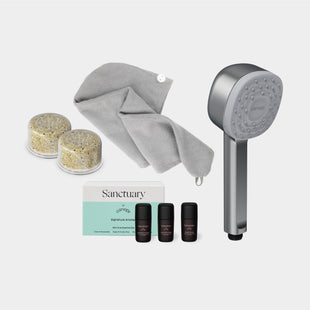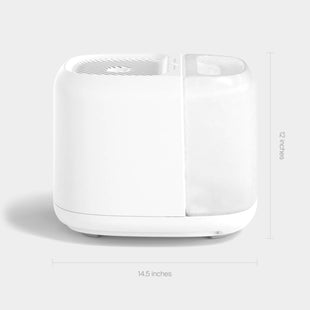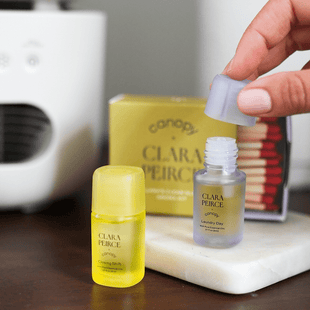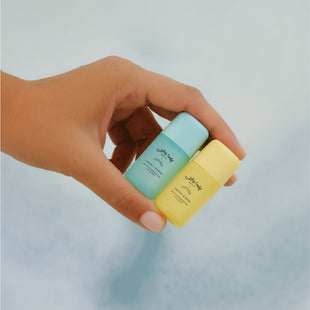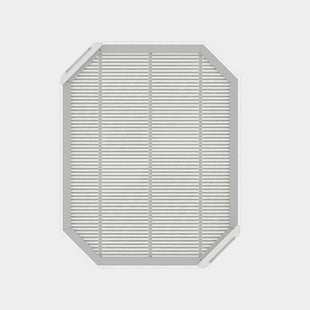You probably spent a pretty penny, or plan to spend a pretty penny on a great humidifier to improve your overall health and wellness. Regularly cleaning your device ensures longevity creating a greater return on your investment!
Like any other home appliance, a humidifier requires some TLC to maintain optimal performance. Below you will find some quick tips for cleaning and maintaining your humidifier as well as 5 simple steps to deep clean your humidifier.
Tips for Cleaning Your Humidifier
Before we delve into the nitty-gritty cleaning process, here are a few, helpful humidifier maintenance tips to keep in your back pocket:
- Prior to running your humidifier, make sure to dump any sitting water and wipe the device dry.
- Using distilled water in your humidifier is a great way to avoid bacteria and grime build-up in the tank reservoir. Some humidifiers, such as Canopy, don’t need distilled water.
- Follow the deep cleaning steps below at least once per week to ensure fresh, bacteria-free moisture in your home.
- Be sure to replace the filter on your humidifier device every 30 to 60 days (depending on the manufacturer guidelines).

How to Clean Your Canopy Humidifier
Cleaning your Canopy humidifier is a breeze. Since all Canopy components are dishwasher safe, the process is so simple you may question your sanity.
You can clean your Canopy humidifier in 2 simple steps.
Step 1: Disassemble your Canopy humidifier
First things, first: disassemble your Canopy humidifier. You should have 5 easily removable components: the main housing that holds the fan, tray, filter, water tank, and cap.

Step 2: Place Canopy components in the dishwasher
Place the tray, water tank, and cap in your dishwasher. Place the filter (if not being replaced) aside on a dry countertop. Run your dishwasher on a normal cycle. Wipe down the main housing with a damp cloth.
Watch a new show on Netflix. Go for a run. Or, re-organize your cabinets. Enjoy your free time!

How to Clean Your Traditional Humidifier
Whether you have a warm mist humidifier or a cool mist traditional humidifier (ultrasonic or evaporative), the process is identical save different components and a slightly different disassembly process.
The five steps outlined below broadly apply to both cool mist and warm mist humidifiers. Note: it is always best to review your owner’s manual for explicit instructions on cleaning your device.
Briefly stated, here are the steps required to deep clean your humidifier:
- Disassemble your humidifier
- Soak all parts in vinegar
- Scrub the internal surfaces of your device
- Wipe down the exterior with a vinegar-soaked cloth
- Rinse all parts and let air dry
Step 1: Disassemble your humidifier
Start by unplugging your humidifier from the outlet. Remove any loose cords from the device base and place them in a safe, dry place.
It’s disassembly time! Unlock, unlatch or unscrew any removable parts from the base of your humidifier and dump any sitting water from the water tank. Lay all of the humidifier parts on a dry towel and proceed to step two.
Step 2: Let vinegar work its magic!
All you need is white vinegar* for a healthy, deep clean. Pour the white vinegar directly into the base of your humidifier until it reaches the brim. Let the vinegar sit in the base for 30 minutes.
Fill your water tank nearly half-way with white vinegar. Replace the cap or seal of your tank and shake that bad boy for 1-2 minutes or as long as your arms can handle. Crossfit athletes: now is your time to shine. Set the tank aside and let the vinegar marinate for 30 minutes.
Lastly, fill a separate bowl or container with vinegar and place any smaller parts into this bowl. Let these components soak for - you guessed it - 30 minutes.
*Why white vinegar? Vinegar is an all-natural cleaner that can effectively destroy dirt, grime, and germs that have built-up in your humidifier device.

Step 3: Time to scrub
Once you hit the 30-minute mark, dump the vinegar from the water tank, base, and bowl.
Grab a scrub brush or a spare toothbrush with soft bristles and get to scrubbing! This step will loosen any dirt, debris, or bacteria that may not have completely dissolved from the vinegar rinse.
Step 4: Wipe down the exterior
Soak a washcloth or a sponge in white vinegar and wipe down the exterior of your device. This includes the outside of the water tank, base, and any other non-electrical part of your humidifier.
Step 5: Rinse and air dry
Now it’s time to rinse all that loose grime from your device. Run the water tank, base, and all small parts under tap water. Be careful not to submerge any electrical parts of your device to avoid damaging your humidifier.
Lay all parts of your humidifier on a dry towel and let them air dry.
Why is Canopy Better?
Traditional humidifiers emit a messy mist that can cause hazardous mold build-up on walls and fabric if not positioned properly. Traditional humidifiers are also more inclined to develop bacteria, mold or viruses if the tank is not cleaned and refilled daily; speaking of cleaning, traditional humidifiers also require more elbow grease to ensure your device functions properly.
The Canopy humidifier is not your average humidifier in design or function. Canopy humidifiers are mist-free, feature a unique mold-inhibiting* design, and contain dishwasher safe components for less hassle, more enjoyment.
Clean Moisture
Our blog Where to Place Your Humidifier outlines the hazards of placing your warm or cool mist humidifier too close to bedding, curtains, or walls. In summary: mold. Lots of it.
Canopy humidifiers have absolutely no mist. Yes, we said that right! Canopy releases pure, clean moisture into the air. You don’t have to worry about messy, unruly mist ruining your wood countertops or destroying the fabric of your bedding or curtains.
Mold-Inhibiting* Design
Furthermore, Canopy humidifiers have an innovative mold-inhibiting* design where smart sensors that detect when water is still sitting in the tank automatically keep the fan running until the inside is nearly dry.
As an extra layer of protection, Canopy replacement paper filters prevent any remaining contaminants in the water tank from entering the air so you can breathe fresh, healthy air all night (or day) long.
Easy to Clean
Canopy humidifiers are not only easy to disassemble, but all parts (aside from the replaceable paper filter and main housing) are dishwasher safe. Save precious time and place the humidifier components in the dishwasher for a quick, deep clean.
Bonus: you can save time and money by purchasing a Canopy filter subscription. This subscription option automatically sends a new filter to your doorstep every 45 days for only $10 ($15 value). In addition, choosing the filter subscription option at check-out takes $25 off your Canopy humidifier purchase. Win, win.
*Mold inhibition limited to device interior. Does not treat air or environment. 3rd party lab-tested with Aspergillus niger (ATCC 6275, 16404).








